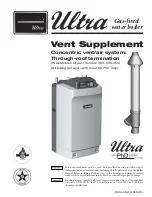
© MHG Heating Ltd
44
MHG Heating Ltd Unit 4 Epsom Downs Metro Centre, Waterfield, Tadworth, Surrey KT20 5LR
Telephone 01737 358000 Fax 08456 448803 Email
Web www.mhgheating.co.uk
010517
12.0 Routine Inspection and Servicing
As with all Gas Appliances, we would highly recommended that a competent heating engineer services the Wallcon, at
least every 12 months. This is assuming a normal daily usage of 8
– 10 hours.
If however the boiler is to be operated 24 hours a day, 7 days, we would recommend services every 6 months.
Wallcon boilers will display an E105 Error Code when 12 months has lapsed, indicating that the appliance requires a
Routine Service Inspection.
(E:105 Indication Reset)
If the Installer/Commissioning Engineer is unable to undertake the Routine Service Inspection, as detailed, please
contact the MHG Technical Department, who will be able to arrange the Routine Service Inspection to be undertaken.
12.1 Routine Service Inspection
Before commencing any service/maintenance work, the following tasks must be undertaken.
a) Ask the end user about any problems with the operation of the boiler unit and note their comments.
b) Check the water pressure of the installation.
c) Remove the boiler casing and visually inspect all pipe and water joints for signs of leakage.
d) Inspect the top of the casing and the top of the heat exchangers for signs of water leakage or ingress.
e) Run the unit in Commissioning Mode HIGH FIRE; with the use of a flue gas analyzer record the CO
2
level.
f) Run the unit in Commissioning Mode LOW FIRE; with the use of a flue gas analyzer record
the CO
2
level.
g) Listen to the sound of the combustion fan. Utilizing the appliances fascia review the unitsOperating Error Codes,
and note the recorded codes onto the Service Report.
h) Undertake a System Water Analysis to check the concentration level of the Water
Treatment, and note the level
onto the Service Report.
i) Check the flue route including the terminal position for conformity with prevailing regulations, and trim back any
foliage that may be around the terminal.
j) Check the plant room/compartment ventilation system for conformity with prevailing regulations.
k) Check the Pressure (Safety) Relief Valve size, rating and orientation, for conformity with prevailing regulations.
The results of the Inspections undertaken above must be acted upon, and all discrepancies should be recorded on the
Service Report and brought to the Client / End User‟s attention.
Undertake any maintenance, and if necessary any prev
entative maintenance, that‟s required.
12.2 Routine Cleaning &Maintenance (E:105 Indication Reset)
As part of the Routine Service Inspection, certain areas of the boiler need to the checked and cleaned as necessary.
a)
Turn the boiler OFF at the ON/OFF switch and electrically isolate the boiler by removing the plug or fuse from the
boiler supply.
b)
Turn off the gas at the boiler isolation tap, fitted by the installer, adjacent to the appliance.
c)
Remove the control panel retaining screws and allow controller to fold forward. Remove the controller mounting
bar via the small screws at either end.
d)
Remove the electrical connectionsfrom the units fan assemble.
e)
Disconnect the earth lead, HT cap and Lead from the ignition electrodes. Also removing rectification lead from
probe.
f)
Ensuring the gas isolation valve is off, undo the union connection to the inlet of the gas valve.
g)
Disassemble the burner by removing the six M6 nuts around the burner door, using a 10mm Spanner. Pull the
burner forward and remove from the heat exchanger. Gently put to one side.
h)
Once access has been gained to the combustion chamber and front section of the heat exchanger, visually
inspect the heat exchanger coils.
If any coils appear to be significantly dis-coloured, then a blockage of either scale, magnetite, or general system
debris has occurred which will have allowed excessive overheating to have occurred within the coil.
If dis-colouration has occurred, then specialist de-scaling of the heat exchanger will be required, however, stress
cracking may have occurred, and the heat exchanger may become porous following the de-scale works.
i)
If the heat exchanger has not suffered from dis-
colouration, as „Item g‟ above, then a Standard Service can be
undertaken. Using a natural bristled brush ONLY, remove the worst of the mineral/debris build up.
With the use of the dissolved
MHG Combustion Chamber Cleaning Granules
, spray the solution onto the heat
exchanger surface and leave for approximately 5 minutes. This will help to remove any stubborn mineral deposits
and clear the condensate drain connections. Finally brush the heat exchanger whilst rinsing thoroughly with
copious amounts of fresh water.
MHG Combustion Chamber Cleaning Granules
are available from MHG










































